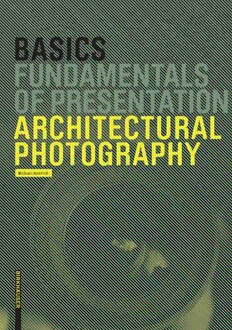
Basics Architectural Photography PDF
Preview Basics Architectural Photography
BBBBBBBBBBBBBBBBBBBBBBBBBBBBBBBBBBBBBBBBBBBBBBBBBBBBBBBBBBBBBBBBBBBBBBBBBBBBBBAAAAAAAAAAAAAAAAAAAAAAAAAAAAAAAAAAAAAAAAAAAAAAAAAAAAAAAAAAAAAAAAAAAAAAAAAAAAAASSSSSSSSSSSSSSSSSSSSSSSSSSSSSSSSSSSSSSSSSSSSSSSSSSSSSSSSSSSSSSSSSSSSSSSSSSSSSSIIIIIIIIIIIIIIIIIIIIIIIIIIIIIIIIIIIIIIIIIIIIIIIIIIIIIIIIIIIIIIIIIIIIIIIIIIIIIICCCCCCCCCCCCCCCCCCCCCCCCCCCCCCCCCCCCCCCCCCCCCCCCCCCCCCCCCCCCCCCCCCCCCCCCCCCCCCSSSSSSSSSSSSSSSSSSSSSSSSSSSSSSSSSSSSSSSSSSSSSSSSSSSSSSSSSSSSSSSSSSSSSSSSSSSSSS Die Architekturfoto grafie ist für Studenten ein wichtiges Mittel, sich mit gebauter Architektur auseinander zusetzen oder FUNDAMENTALS auch eigene Projekte zu dokumentieren. Basics Architektur fotografie erläutert OF PRESENTATION praxisnah die w ichtigsten technischen Grundlagen der Fotografie, der Bild- A R C ARCHITECTURAL analyse und der Weiterverarbeitung H IT E von Foto aufnahmen und gibt Tipps für K T U R die eigene Arbeit. F O PHOTOGRAPHY T O G R A F IE Michael Heinrich D A R EENNTTWWEERRFFEENN S T DARSTELLUNGSGRUNDLAGEN E L KKOONNSSTTRRUUKKTTIIOONN LU N BBEERRUUFFSSPPRRAAXXIISS G S BBAAUUPPHHYYSSIIKK UUNNDD HHAAUUSSTTEECCHHNNIIKK G R BBAAUUSSTTOOFFFFKKUUNNDDEE U N LLAANNDDSSCCHHAAFFTTSSAARRCCHHIITTEEKKTTUURR D L SSTTÄÄDDTTEEBBAAUU A G TTHHEEOORRIIEE E N B A S IC S www.birkhauser.com Michael Heinrich Architectural Photography MBeicrth aBeiel lHefeeilndr i-c Shebastian El Khouli AEnrtcwhiutrefcstiudreael Photography Birkhäuser BIRKHÄUSER Basel BASEL Contents Foreword _7 IntroductIon _9 Fundamentals oF photography _11 Optics _11 Principles of representation _12 Recording the image _16 the camera _19 Image quality _19 Objectives _20 Control elements _22 Camera types _25 Accessories _30 Image analysIs _31 Image factor: content _32 Image factor: reproduction _38 Image factor: graphics _43 the photograph _49 The series _49 Divergent lines _50 Order _50 Weather _53 Interior shots _54 Artificial light _54 Construction sites _57 Photographing models _58 processIng the Image _60 Scanning _60 Importing images _60 Selecting images _61 Image edItIng _62 Resolution _62 Colors _63 Storage formats _64 Parameters _65 Correcting image errors _66 Retouching _67 Special techniques _68 The image as end product _69 the archItect and communIcatIons medIa _71 In conclusIon _73 appendIx _74 Literature _74 Photographs: technical information _75 The author_78 Foreword An important way for architects to introduce themselves to the pro fessional world and acquire new clients is through effective presenta tions of their work. Books, journals, brochures and websites are some of the forums that architects use to publish plans, perspective drawings and photographs. The quality of the images presented in these contexts is highly significant, since they are often the only medium available to architects for informing outsiders about their work. The presentation of work to the outside world is not the only func tion of architectural photography. The camera is an architect’s constant companion on construction sites, trips and surveys. It provides a perma nent record of completed buildings, impressions and ideas that may later inform the architect’s own work. Depicting a building presents the photographer with special chal lenges. Buildings can hardly be positioned and photographed in a studio. They are part of public space and are often elements in a closely inter connected urban context. They are used on a daily basis, inhabited and exposed to the elements. These aspects are not always desirable when it comes to photographing buildings, and they thus present both techni cal and aesthetic challenges. The photographer also has to be cognizant of the architect’s interest in having his or her intentions and design prin ciples optimally reflected in the image. In this sense, architectural photo graphy cannot be equated with documentation. It is also a formative medium that is influenced both by the insights of the photographer and by the architectural perspective. Architectural Photography makes an important contribution to the general field of object representation. The book begins with a discussion of the technical fundamentals of photography in order to help students develop the skills required to photograph constructed architecture and their own work at a professional level. The chapter “Image analysis” de scribes the typical design parameters used in architectural photography and illustrates them using a number of examples. It then outlines estab lished procedures for shooting architectural subjects. Editing and adapt ing raw photographic material is an everyday part of producing architec tural images. This book therefore uses a range of examples to illustrate the different ways of processing images and the different techniques of digital image editing. It offers architecture students and readers with a general interest in the subject a solid, practical foundation on which to build the skills required to produce highquality photographs. Bert Bielefeld, Editor 7 8 Introduction Architects, urban developers and structural engineers develop their architectural ideas largely with the help of architectural photographs. Such photographs assume a mediating role between architecture and the observer, but they can never completely reproduce a building, since they only show a particular perspective. The photographer selects a specific point of view, deciding what he or she would like to show the observer. It is therefore wise to make a thorough study of the details of an architectural object before photographing it. Reproducing a threedimensional building in a twodimensional Concept medium confronts the photographer with the fundamental difficulty of depicting interrelationships and spatial impressions. Over and above this, a concept for communicating architectural context needs to be based on an analysis of the structures of a building, the fundamental ideas inform ing its design and the context in which the building has been positioned. Apart from an understanding of architecture, it is also necessary to have a knowledge of how designs are realized in technical terms, a sense of proportion, and the ability to select the right content for photographs. > Chapter Image analysis The chapters below provide insights into the technical fundamentals of photography, image analysis, photographic techniques and the sub sequent adaptation and editing of architectural images. 9 10
